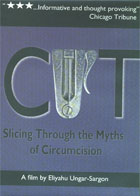
Cut: Slicing Through the Myths of Circumcision 2007
Distributed through the Cut website.
Produced by Pennie Ungar-Sargon
Directed by Eliyahu Ungar-Sargon
DVD, color, 70 min.
College - Adult
Jewish Studies
Date Entered: 02/22/2010
Reviewed by Sheila Intner, Professor Emerita, Graduate School of Library & Information Science, Simmons College GSLIS at Mt. Holyoke, South Hadley, MAAn objective documentary on a controversial subject, Cut does an excellent job of presenting the arguments for and against circumcising boys soon after birth. Starting with the Jewish religious imperative that prompts brit milah, or the covenant of circumcision, it goes on to question the origins of the practice as a recommended procedure for non-Jews as well as for Jews, and the scientific justifications that have made male circumcision what the filmmaker calls “the most common surgical procedure in America.” Yet, despite its forthright and generally balanced treatment of its subject, it is not completely free of the shadows and nuances of religious and racial prejudice. Perhaps, the most crucial issue of all, Mr. Ungar-Sargon questions the right of adults to impose the procedure on newborn babies who might or might not have wanted it to be done had they been able to have a voice in the matter.
Mr. Ungar-Sargon interviews his younger brother, whose circumcision is preserved by family photographs, wondering out loud what it signified. He talks with their father, a loving parent and beloved rabbi, about the religious meaning of circumcision. He finds a Jewish couple expecting a baby boy, who share their thoughts about both the procedure and the ceremony, which are not one and the same. At the end of the film, viewers watch the circumcision of their eight-day-old baby, performed by the mother’s obstetrician, doubling as a mohelet—a female ritual circumciser. (Note: Only liberal Jews permit women to serve in this capacity—Orthodox Jews find it unacceptable.) This reviewer must admit she was unable to keep her eyes on the screen during the procedure.
The physical effects of circumcision are revealed in interviews and graphic visual displays, both live and photographed, all treated respectfully and seriously. Statistics experts at the University of Chicago are questioned about the veracity of the data surrounding scientific claims about the benefits of circumcision for male sexual health. Physicians and advocates who lobby for and against circumcision are interviewed about the claims, with the naysayers generally getting the upper hand. Those who favor circumcision are not given short shrift, and all have their say. At the end of the day, the science does not seem to be crystal clear, whereas, in contrast, the religious requirement is unassailable. Mr. Ungar-Sargon questions his father whether a man can be a Jew without being circumcised. His answer, like most answers concerning religious beliefs, is based on faith, not science.
The film closes, dramatically, with Mr. Ungar-Sargon, anticipating fatherhood someday, exclaiming that his Jewish faith gives him the right to free choice, including the right to disobey the commandment to circumcise his progeny.
Recommended.